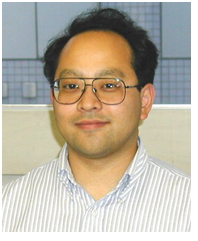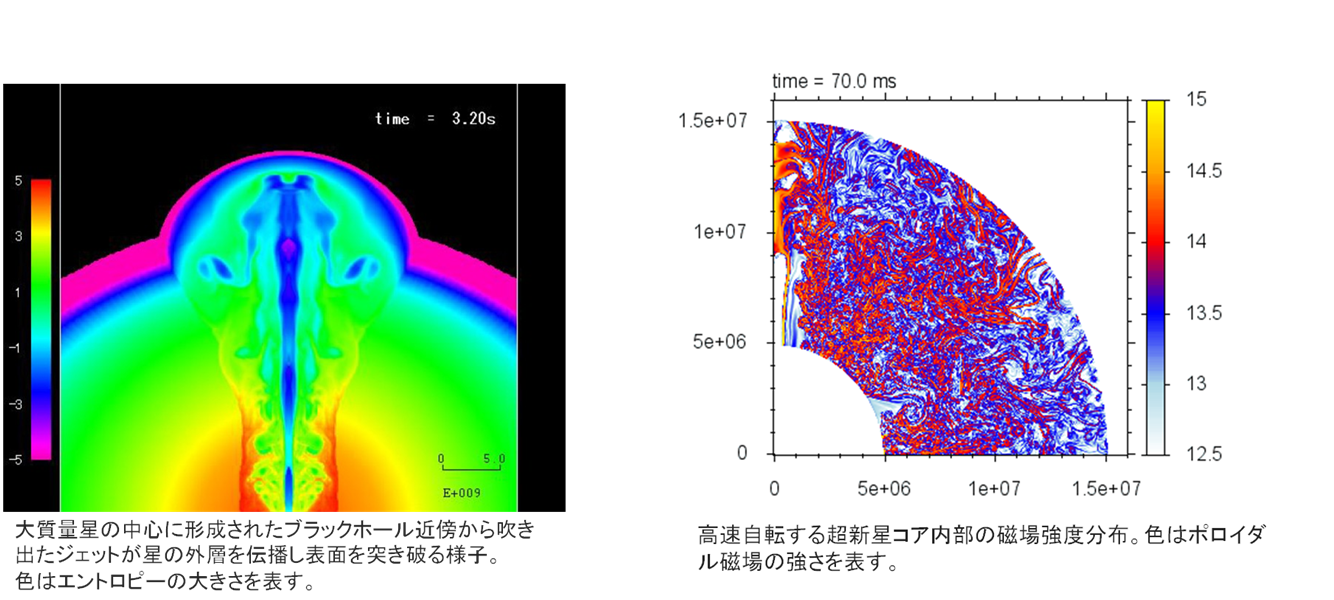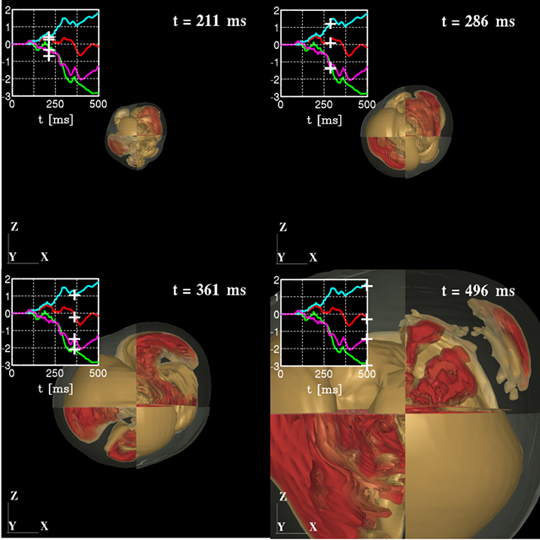
ページ読込中...

ページ読込中...

[English]
| 山田 章一 [教授] |  |
|
| homepage | https://www.heap.phys.waseda.ac.jp/index.php | |
| 専門分野 | 宇宙物理 | |
| 研究テーマ・研究活動 | ||
| ○高エネルギー天体の物理 | ||
| ●日本天文学会 ●日本物理学会 |
||
宇宙には、地上では考えられないような高エネルギーの現象がたくさんあります。私が主たる研究テーマとしている超新星もその一つです。超新星は突発天体で、ある日突然明るく輝きだし、数ヵ月の単位で暗くなっていきます。昔の人には新しい星の誕生ととらえられ、超新星と名付けられていますが、超新星は新しい星の誕生ではなく、実は非常に大きな星が爆発を起こして死んでゆく姿です。超新星は非常に明るい天体です。銀河は100億個程度の星の集まりですが、超新星はそれ一つでこの銀河一つ分に匹敵する明るさを持っています。爆発のエネルギーに直すと、太陽から地球が一年間に受けるエネルギーより、約20桁も大きなものになります。しかもこの莫大なエネルギーがわずか1秒という時間のうちに放出されます。どれほどの高エネルギーであるか想像していただけるでしょうか。このような高エネルギー現象では、いろいろ地上では考えられないようなことが起こります。神岡鉱山の観測装置スーパーカミオカンデでは太陽や宇宙線から生じるニュートリノという素粒子を観測していますが、超新星は莫大な量のニュートリノを放出します。事実、1987年に我々の天の河銀河のとなりにある大マゼラン星雲という銀河で起きた超新星では、スーパカミオカンデの前身であるカミオカンデ観測器により世界で初めて超新星ニュートリノが観測され、小柴さんがノーベル賞を受賞しました。また、超新星が起こった後には、中性子星やブラックホールといった、宇宙のいわゆるコンパクト高エネルギー天体が形成されると考えられており、超新星の研究はこうした興味深い天体の形成メカニズムを研究することにもなるわけです。
最近では、超新星以外にもいろいろな高エネルギー天体が注目をあつめています。γ線バーストはおよそ1日に1回の頻度で宇宙のあらゆる方向から等方的にγ線がやってくるという現象です。γ線は最もエネルギーの高い光で、これを発している天体現象はまだよく分かっていませんが、大質量星が重力崩壊しブラックホールになる過程でγ線バーストは起こっているのだろうと考えられており、超新星とも密接に関係していると思われています。下図左は、ブラックホールが形成される際に放出される高速ガス流(ジェット)のシミュレーション結果です。他にも、地上で最も強い磁石より10桁以上も強い磁場を持った中性子星が発見されており、どのようにしてそのような強い磁場ができるのか、多くの人が興味をもって研究しています。下図右に示したのは、高速に自転する超新星コアの中で磁力線が乱流のために複雑に絡みあい、磁場が強くなる様子をシミュレーションで計算したものです。観測的にも、従来の電磁波によるものだけでなく、ニュートリノや重力波を用いてこうした高エネルギー天体を観測する”新しい天文学”が開花しつつあり、高エネルギー天体物理学は今非常に面白い時期を迎えています。上述のように、こうした高エネルギー天体は互いに密接に関係していると思われ、これらを統一的に理解することが今後重要になっており、私の研究もそうした方向に向かっています。

| Shoichi Yamada [Professor] |  |
|
| homepage | https://www.heap.phys.waseda.ac.jp/index-e.php | |
| research field | Neutrino and gravitational wave astronomy of massive-star collapse | |
| research keywords | ||
| High energy astrophysics Mechanism of collapse-driven supernovae and physics of hadronic matter at high densities Neutrinos and gravitational waves from the formation of black holes and neutron stars |
||
| link | ||
| Research Profiles (at Faculty of Science and Engineering)Research Profiles (Elsevier SciVal Experts) | ||
Gravitational collapse is the common fate of massive stars, followed by the formation of compact objects such as neutron stars and black holes. This gravitational collapse is initiated by the central core of a massive star, which is surrounded by massive envelopes and cannot be probed by electromagnetic waves. The actual conditions in these regions have been inferred over the years based on indirect evidence for example, nucleosynthetic yields. This may have already changed dramatically, however, with multiple terrestrial detectors of neutrinos and gravitational waves now deployed, operating, and poised to detect the next event.
Since neutrinos and gravitational waves interact very weakly with matter, they escape the central core unhindered, carrying information on the environment where the emissions originate. Although the very weakness of the interactions once constituted a major challenge for experimentalists, this is no longer the case. The ball is once again in the theoreticians’ court. Needed now are quantitative predictions to compare against observations. As the detection of neutrinos from SN1987A clearly demonstrates, neutrinos from core-collapse supernovae and the proto-neutron stars that form subsequently should be among the primary targets in neutrino astronomy.
Also emerging now is gravitational-wave astronomy. Over the last decade, we have witnessed significant progress in the international network of detectors, including LIGO, VIGRO, GEO600, TAMA300, and AIGO, and the direct detection of gravitational waves from astrophysical events should soon be possible.
Promising sources would include a massive star collapse, particularly within our own galaxy.
Over the years, in large-scale numerical simulations, we have demonstrated that the detection of neutrinos and/or gravitational waves emitted by the gravitational collapse of massive stars will convey much information not just about what goes on under the thick veil of the massive envelopes, but about the properties of dense and hot baryonic matter. In so doing we have pointed out the importance of black-hole-forming events, which are still putative but, if observed, will provide invaluable and otherwise inaccessible information. In fact, the neutrino bursts from the optically silent collapses of massive stars have unique characteristics that distinguish them from ordinary supernova neutrinos; hence, they can be used not just as indicators of black hole formation, but as probes of dense baryonic matter. It is fascinating that such an event may be confirmed by the detection of “the disappearance of one of the numerous massive stars” monitored optically as another proposed initiative. If the progenitor star is rotating, we will also have the chance to detect the event via gravitational waves.

Four snapshots of our 3D supernova simulation. The length of each side of the plot corresponds to 1000 km. The entropy distributions are shown. The second and fourth quadrants of each panel show the surface of the shock wave. The high entropy bubbles (colored red) in the section cut by the $ZX$ plane are displayed in the first and third quadrants. The insets show gravitational waveforms from anisotropic neutrino emissions.